Sand Top Dressing is such a common operation on bowls greens that it seems likely that it must be doing a lot of good, but is it?
I’ve unintentionally become the anti-top dressing guy in some fine turf circles and quite often cause a stir on social media by saying things like “thatch can’t be diluted with sand“. I also get a lot of emails from readers about all aspects of greenkeeping and club management where correspondents mention their continued use of sand top dressing somewhat apologetically and in hushed tones. For the record, I am not anti-topdressing as such, just anti-topdressing for the sake of it, rather than for any good agronomic or performance reason. That said, I maintain that the majority of greens in the UK are already too sandy and continued use of sand top dressing is causing their condition to get worse rather than better.
The main problem with sand top-dressing is that most of it is done blind, or in other words without the right information to hand.
What’s the right information?
Before embarking on a top-dressing program you need to know:
- The current condition of your soil, generally, but especially in terms of its physical make up.
- Your reason for top-dressing; “just because” isn’t good enough!
- The physical makeup of the top-dressing material you intend to use.
Today then, I want to look at the issues surrounding sand top dressing. I want to address the soil science facts that lie behind the decisions to top-dress greens and I want to dispel some of the myths that are now inextricably linked to top-dressing.
I’ll start with a question: “is sand top dressing ever appropriate?”
The answer is yes, top-dressing is sometimes appropriate and in fact regular top-dressing is even beneficial in some cases, but to do that properly, we MUST understand what we are doing and why we are doing it. I see a lot of ill advised and terribly executed top-dressing programs. This is the reason I’ve become the No Top Dressing Ogre, because unless a lot of ducks are lined up in a row, it is usually better for the green in question, NOT to top-dress. Top-Dressing then, is a thoroughly mis-understood greenkeeping concept. The reasons for doing it are misunderstood, the materials are misunderstood and the resulting damage from getting either or both of these wrong is a green that is worse than when you started.
If routine, sand top-dressing regardless of underlying conditions was of real benefit to greens, it surely must follow that the majority of greens in the UK would be of a very high standard now after 40 or more years of it. The truth is that most greens are at best no better for all of this expense and effort and a great many are in far worse condition, in terms of health and performance than when top-dressing first became sexy. And that is in no small part, down to indiscriminate use of sand as a top-dressing. We still have to fight the seemingly never ending battle with thatch, disease, Poa annua and hydrophobic dry patch, with no real improvement in the incidence of bumps, bad levels and bad runs top dressing is purportedly so good at ridding greens of.
Like many other greenkeeping operations, top-dressing suffers from More Syndrome, which says that if a little is good, more must be better!
Top-dressing can be beneficial, but in its current form at many clubs, it is damaging greens beyond economic or timely repair. In my experience, most UK bowling greens don’t need any more sand in their rootzone.
The Purpose of Sand Top Dressing
There are some spurious and mythical reasons given for top-dressing greens including the Dilution of Thatch. This is nonsense and I explain why here.
Before we go any further then, let’s investigate the real reasons for top dressing and they are as follows:
- Smoothing and levelling the surface
- Soil exchange to improve soil composition
Smoothing and Levelling the Green Surface
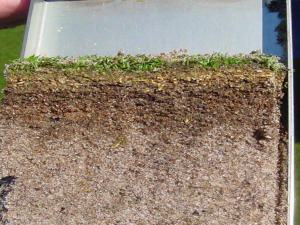
Much of the top-dressing applied to bowling greens is in this category. It is applied in order to smooth the green surface in an effort to improve playing performance.
While it is easy to see why clubs would want to achieve smoother, firmer greens, lack of top-dressing is rarely the problem that is being addressed.
By far the biggest cause of uneven, bumpy green surfaces is an excessively thick thatch layer at the surface of the green.
A thatch layer of say 13-25mm, which isn’t uncommon on bowls greens that have been conventionally maintained, has an inherent ability to shrink, expand or to be compressed by foot and machinery traffic by 10 or more millimetres. It will vary widely over the course of the season with the main influence on this variability being the amount of moisture the thatch repels or absorbs.
In wet weather, the thatch layer will absorb and hold water at the surface. Many of the clubs I speak to who have drainage problems, actually don’t have drainage problems. They have thatch problems. When the soil profile is examined, many drainage problems are shown to be caused by thatch at the surface holding on to excess water much like a sponge would.
In dry weather, the same layer of thatch, which is simply a build up of un-decomposed organic material discarded by the grass plants, will dry out completely and go hard and bumpy. The drying out process will make it shrink back from the general level of the surface unevenly across the green.
Faced with the potential for such wide changes in levels caused by thatch alone, top dressing with sand as a means of smoothing the green surface is not just futile, but also damaging to the green in the longer term. The damage comes from burying un-decomposed thatch under sand which causes dense, dry and hydrophobic mat in summer and spongy wet, anaerobic turf in winter.
Doing the Maths
The sand or top-dressing mix (mostly sand) used for top-dressing is typically made up of at least 60-70% Medium Sand (0.25mm 0.50mm diameter particles). Most top-dressings are between 3 and 5 tonnes per application. Let’s do the sums and see how much of a covering that would provide in terms of levelling ability:
Average green size 36m X 36m =1296m2
With approximately 1.8 Tonnes of sand to the cubic meter, a 3 Tonne application provides about 1.7m3 of top dressing material.
To calculate the depth of cover we divide the volume of the material by the area to be covered as follows:
1.7/1296 = 0.0013m in depth or 1.3mm of top-dressing cover.
For a 5 tonne application the figures look like this:
2.8/1296 = 0.0021m in depth or 2.2mm of top dressing cover.
Even if this was the right thing to do, faced with potential vertical movements within the thatch layer of 10mm plus, the idea of using top-dressing to smooth out bumps and hollows is flawed.
In reality all this does is drop a layer of sand on top of un-decomposed thatch and the two combined make dense, impenetrable mat.
Dressing for smoothness on healthy greens
On greens that have the optimal thatch depth (5mm or so) and that have living, vibrant soil microbiology and fine perennial grass cover the case for top-dressing for smoothness is more acceptable.
If your greens are in this state of health and if this is a thing you feel you want to do , then the top-dressing must match closely with the Particle Size Distribution of the underlying rootzone material. If it doesn’t you will merely be creating layers. Layers of trouble for the future I might add as you start to slowly lose the homogeneity of your rootzone again.
Here’s a funny thing. Once your green is in this healthy state, the need for any additional work to make it smooth diminishes and can mostly be taken care of via the routine maintenance of mowing and light aeration.
Top Dressing for Soil Exchange
Now, don’t tell anyone, but I’ve quite often recommended top-dressing as a means of soil exchange on greens that are built of heavy native soil. Actually I’ve deliberately built golf greens with the natural soil from the site with the intention of doing top-dressing as soil exchange during the grow in period and first few years after opening and it works a treat.
To get your head fully around this, it’s important to understand the physical attributes of soil and in particular, soil texture or Particle Size Distribution. If you’re happy with these terms read on, but if you need a catch up, the earlier articles in this series about Soil Texture can provide for that starting here.
Basics of Soil Exchange
Long version:
Soil exchange top-dressing is fairly self explanatory. You take some of the natural soil out, usually with an aerator of some sort and replace it, usually with sand that conforms to the characteristics of the sand component of the final Particle Size Distribution you want to achieve in your green. Particle Size Distribution dictates drainage performance, moisture retention, nutrient availability and overall green playing performance.
Short version:
Hollow tine the green and chuck some sand down the holes.
Missing the Point with PSD
Unfortunately, although this is much easier to get right than top-dressing for smoothing and levelling, I see a lot of people following the short version above. I’m afraid this often causes them to miss out the vital details about that confusing Particle Size stuff contained in the long version.
Particle Size Distribution (PSD) or Soil Texture influences and even determines a lot of what makes a green good or bad, including levels, drainage, nutrition and moisture availability to name but 4.
Homogenous Rootzone
The point that must not be missed with soil exchange is that we are trying to create, over time, a high performance rootzone that is of the same or very similar make up throughout the soil profile. Making holes and adding sand would be a riskily blunt instrument for this if it wasn’t for earthworms and soil microbes.
Over a period of years, it is possible to turn heavy soil into lovely, free draining homogenous rootzone by varying the depth of aeration and applying a high quality river or quarry sand of uniform particle size down the holes. The worms and subsequent aeration will do most of the mixing of sand and soil. Meantime the soil microbes (which will be increasing in population due to the extra oxygen) will add humus as they decompose the organic material (leaves, shoots, stolons etc) discarded by the plants and dragged below ground by the worms.
Using this method, it is possible to convert a heavy soil green into one with a rootzone approaching USGA specification, but what is that and why would you want it?
Understanding the USGA Rootzone Specification
There is so much guff spoken about USGA golf greens, but I’m hoping a short paragraph or ten of introduction will help you to see why the USGA specification for putting green construction, and particularly the rootzone specifications is a very helpful benchmark for greenkeepers everywhere.
Golf greens suffer from all of the same problems and misguided greenkeeping as bowling greens do. The United States Golf Association (USGA) found it increasingly difficult to be sure that a golf course was going to perform to the standard expected for tournament play. Back in the 1950’s and 60’s their well funded and expert heavy Greens Section developed a method for standardising golf green construction.
Now, since then there have been a lot of purists who have baulked at (and complained vociferously about) the idea of a standardised green, but the reality is that this method merely seeks to make the agronomic performance (drainage, moisture retention, nutrition etc) more predictable. In practice, the USGA greens on one course, although built by following the specification closely, will be specific to that course and very different in terms of look, feel and playing experience to the USGA spec greens on another.
It’s a bit like music in a way. I have a very similar guitar and amplifier to the ones Eric Clapton uses, but instead of my guitar “gently weeping”, it’s my neighbours and friends who come over tearful when I play. It sounds a bit like an injured cat that has got under the lid of Les Dawson’s baby grand during a performance!
I am then, a fan of the USGA Specification, not merely as a method of construction but also as an instrument of education for greenkeepers when it comes to understanding how soils work.
To boil USGA down to its essence, the specification is an attempt to make it possible to build greens economically, that closely replicate the performance of those natural wonders found on the Links at St Andrews and elsewhere around the coast of the UK and Ireland.
The rootzone specification for USGA greens looks like this:
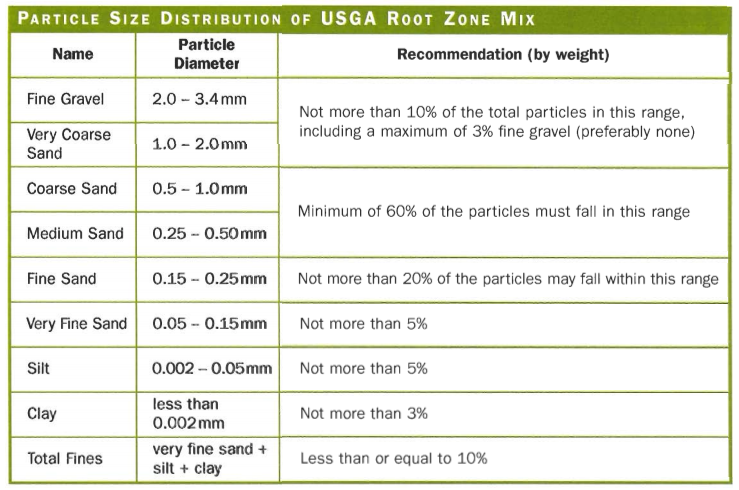
Yes it’s our old friend Particle Size Distribution again, but instead of just a random mix of the 7 main soil fractions, this specification is designed to promote a particular set of performance characteristics in the green as follows:
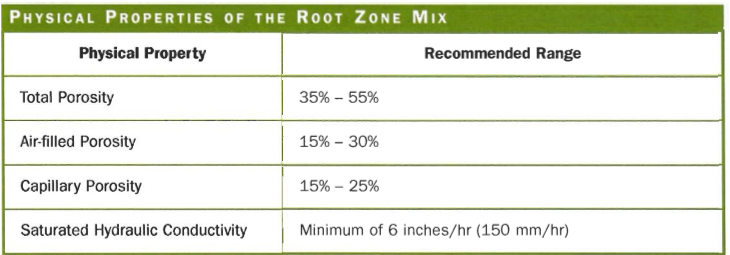
If you’ve been keeping up with this series of articles you will recognise the measurements for soil porosity above from our Perfect Soil Pie chart.
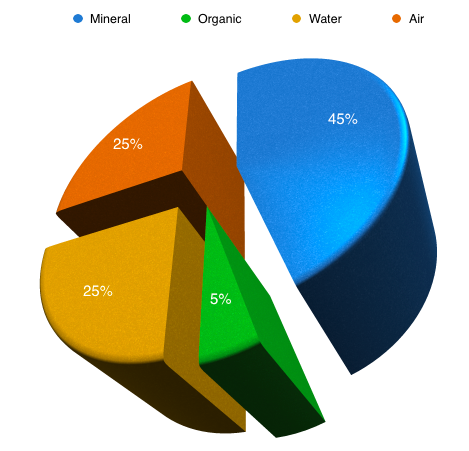
Drainage
Saturated Hydraulic Conductivity is simply the speed at which the green drains water after it has reached saturation point (all pores filled with rain water) The minimum is 150mm (6″) per hour! There are different versions of the USGA specification for areas that get monsoon type rains with 12″ and 24″ hourly drainage rates too!
The standard specification is a good benchmark for bowling greens in the UK to aspire to. This has been good and bad for golf and bowls greens.
The Layman Expert
Our profession is like no other in terms of the layman’s assumption of superiority and more dangerously, his confidence in his own abilities in a field he knows relatively nothing about. This is where someone hears Peter Alliss commentating on the Ryder Cup on the telly. During a lull in play Peter quickly dreams up a bit of filler material:
“the recent rebuild of the course to upgrade the USGA Specification greens has worked remarkably well Ken, don’t you think?”.
With still no play to comment on, Ken Brown interjects:
“certainly has Peter, but what does the USGA spec mean?”
Meantime, Bubba Watson’s Caddy hands him his driver on the 15th tee. As Bubba limbers up and takes a step back to view the fairway, Peter calmly continues:
“ahh, well young Ken, they are mostly made of sand, a bit like the seaside lin…..Ahh what a sweet drive, straight down the middle from Bubba there…just where he wanted it”
Ken instinctively drops the filler talk:
“yes he really has found his form again this week hasn’t he?”
The layman green convenor empties his pint and heads for the bowling club to hatch his new USGA plan for the bowling green…“We need more sand!”
Porosity and Drainage
If these drainage figures worry you and why wouldn’t they. After all 6 inches of rain is a month’s worth of Loch Lomond style precipitation and these USGA greens can get rid of that in an hour! Won’t they dry out too quickly?
This all ties in with our previous look at soil porosity. Remember that we are looking for roughly half of the volume of our soil to be soil pore space (porosity). This is roughly split into two, with half (25% of soil total volume) being Macro pores (aeration, drainage or air filled pores) and the other half being Micro pores (capillary, or water holding pores).
When the green is saturated (all pores filled with water) during and after heavy rain, gravity immediately starts to work on pulling the water out of the Macro porosity and keeps doing so until the green has drained down to a point known as Field Capacity. Field Capacity means that all of the Micro pores are filled with water and all of the Macro pores are full of air. Due to the physics of Micro (capillary) porosity, the water is held against gravity and is available to the plants. The Macro porosity allows for rapid drainage and optimal aeration of the rootzone.
Gravity and Particle Size Distribution
The USGA specification then is simple in its intentions and complex in its execution. I’ve only really touched on the Particle Size Distribution of the Rootzone element of the specification here. Don’t get me started on the drainage layer or the bridging specification of gravel to rootzone or D15/D85 distribution curves!
Suffice to say that the gravitational pull on the water in the rootzone is a key factor in how rootzones drain and as a result, also a key influence on the final specification of greens made using the USGA spec.
In addition to the need to replicate the performance of the traditional seaside links soil, the specification also has to help those building the green to keep costs under control and to be able to predict costs for materials, labour and earth moving reasonably accurately for diverse sites.
These financial considerations combined with the laws of gravity provide an explanation as to why the USGA rootzone specification looks like it does today.
A typical (if there is such a thing) Links golf green has a particle sized distribution graph that looks like this:
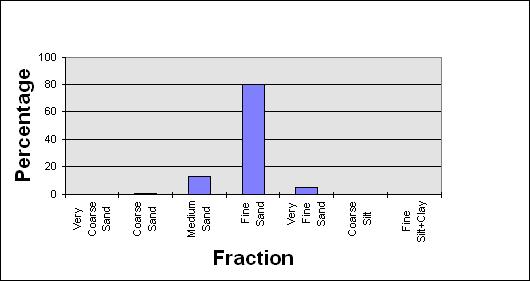
Yes I know, at first glance this looks similar to the Particle Size requirements for USGA rootzones, but on closer inspection you will notice that it is fundamentally different in one respect. Have a look at the PSD graph for a USGA Rootzone now:
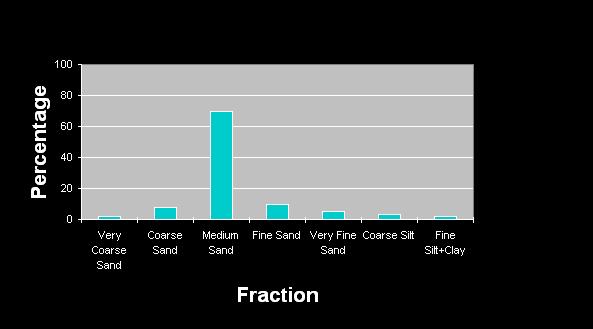
Yes, both graphs show a great deal of uniformity with 70% or more of the sand coming from one of the 5 sand fractions. The difference is that on the Links graph the predominant fraction is Fine Sand (0.15-0.25mm diameter), whilst on the USGA graph the predominant fraction is Medium Sand (0.25-0.50mm diameter).
Why should this be?
As described in a previous article in this series on soil texture, the Links soils are naturally made when the dune sand, previously graded by particle size by the wind is slowly populated with plants. Over time the plants develop, grow, reproduce and die. As they do this, their remains are incorporated into the sand as humus and slowly but surely a real soil forms. Due to their very uniform particle size distribution, these soils drain very well and can easily live up to the 6 inches per hour target set for USGA greens, but due to their PSD being predominantly Fine Sand, the gravitational pull needs to be much greater than we would expect on a USGA green. Links soils are, however, very deep and the extra gravitational pull is provided by this extra depth.
Now, if I wanted to build a green that replicates a links green’s performance using a rootzone made predominantly of Fine sand, I would need, not only a deep excavation to build it in, but I would also need very deep pockets to pay for the materials!
This is why USGA greens use predominantly Medium sand. Using this material it’s possible to replicate the drainage characteristics using a uniform depth of rootzone over the whole green area, which is good for calculating costs. Into the bargain, I could build such a green with just 300mm (12 inches) depth of rootzone material.
You can download the full 2004 USGA Recommendations for Green Construction here.
Particle Uniformity and Aeration
Why all this excitement about particle size uniformity?
A narrow spread of particle sizes in a rootzone allows for greater airspace (Macro porosity) which allows for rapid drainage. However, if all of the particles in the rootzone were the same size, it would remain very mobile and wouldn’t consolidate into a smooth and stable surface and wouldn’t hold onto any moisture. Much like the dry, uniform sand near the dunes at the beach. The stuff that’s hopeless for building sand castles with!
The spread of particle sizes, means that the larger and smaller particles on the shoulders of the PSD graph provide rootzone stability and adequate moisture retention.
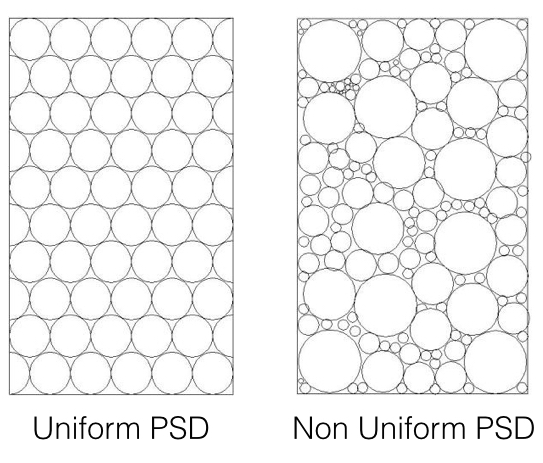
Particle Size Distribution and Top Dressing
Which all brings us neatly to the end of our little journey around the thorny subject of top-dressing greens.
The influence of Particle Size Distribution on the performance of greens is vast and we fiddle with it at our peril. If top-dressing is indeed to be applied to the surface of the green as some means of smoothing or levelling it, then this must only come after we are sure the rootzone is already up to a standard that we know will help the green to perform at its best in terms of drainage, moisture retention and nutrient provision.
In addition to this, the green must already be populated with predominantly fine, perennial grass, have a thriving microbial population that is naturally recycling all of the debris created by the plants to humus without allowing a thick thatch layer to build up. More on that here.
On greens where this is not the case and the soil is heavy and not draining well, this can be achieved by applying the principles of soil exchange mentioned above
If however, all of this is in place and you think your green still needs top-dressing, this must be done using a top-dressing compost that matches the Particle Size Distribution of the rootzone perfectly. Using anything else is going to create layers of differing PSD and undo all of your hard work very quickly. The only thing that can make this worse is if you top-dress on top of excess thatch, which will add the prospect of impenetrable mat into the mix.
The 5 Part Trilogy Complete!
This article completes a trilogy of articles on Soil Texture I started some time ago that somewhat sloppily turned into 4 and now 5 parts. You can catch up with the other parts here:
Questions and Comments
What are your experiences and observations of top dressing?
As always, questions and comments welcome in the comments section below or by email.

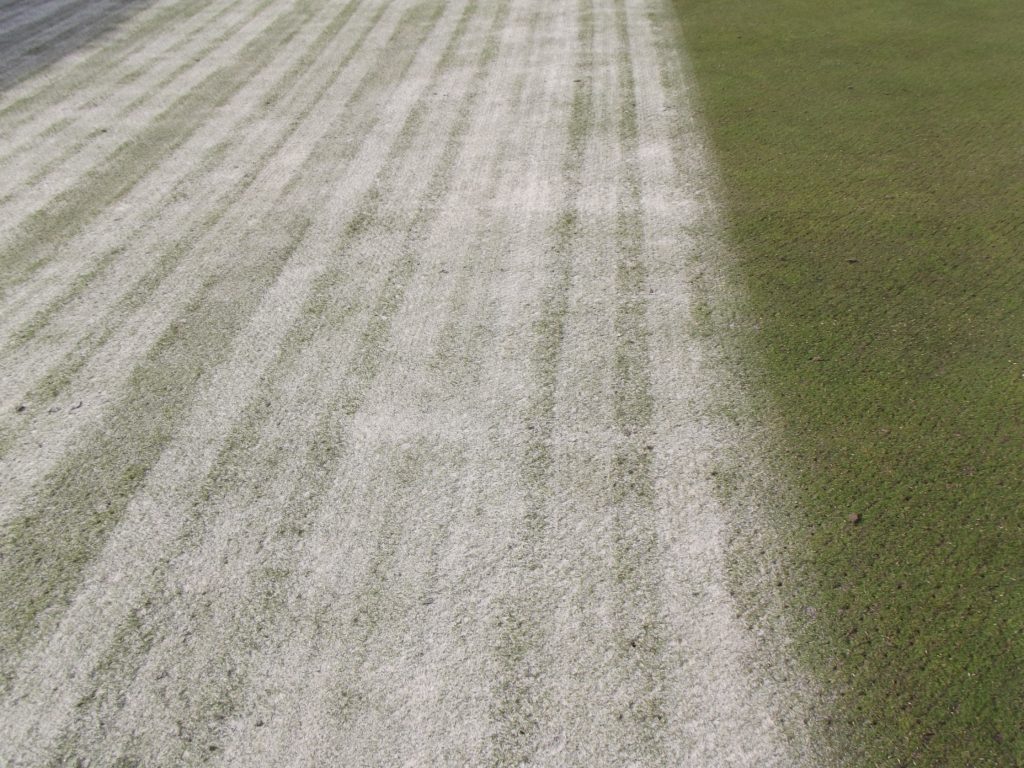
Excellent article, researched and well reasoned.
As always fascinating stuff, I could talk to you over a beer for hours and hours.
Great work.
Really enjoyed this article.
Can you give me your thoughts on the use of Air 2G2 ?
Keep up the good work.
Regards Kevin. Bedford Bowls Club